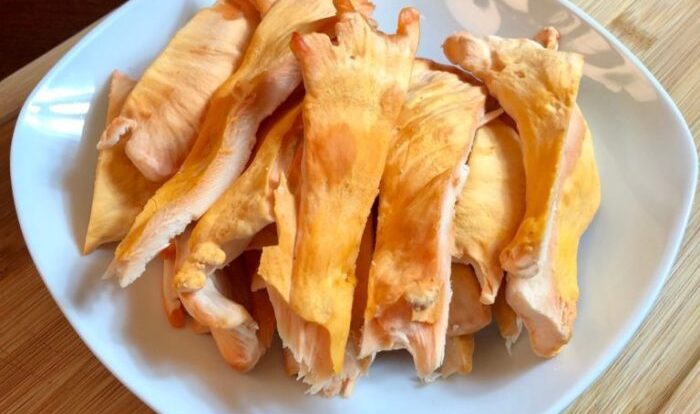
Chicken of the woods recipe, a culinary gem waiting to be discovered! Get ready to embark on a gastronomic adventure as we delve into the world of this unique mushroom, exploring its culinary versatility and surprising health benefits.
From sautéing to grilling, this versatile ingredient promises to tantalize your taste buds with its savory flavors. Let’s dive right in and uncover the secrets of this woodland delicacy.
Identifying the Characteristics of Chicken of the Woods
Chicken of the Woods (Laetiporus sulphureus) is a distinctive and edible mushroom known for its vibrant colors and unique appearance. It is characterized by its bright orange to yellow coloration, which can vary in intensity depending on its stage of growth.
Chicken of the Woods grows in clusters on dead or dying hardwood trees, often oak, maple, or beech.
One of the key features of Chicken of the Woods is its texture. It has a tender and slightly chewy texture, making it a popular choice for culinary preparations. The mushroom’s flavor is often described as mild and slightly fruity, with a hint of acidity.
Chicken of the Woods is also known for its high nutritional value, containing essential vitamins, minerals, and antioxidants.
Distinguishing Chicken of the Woods from Similar Species
While Chicken of the Woods is a relatively easy mushroom to identify, it is essential to distinguish it from other similar species to ensure safe consumption. One key difference is its growth pattern. Chicken of the Woods typically grows in clusters on trees, while other similar species may grow on the ground or on decaying wood.
Another distinguishing feature is its color. Chicken of the Woods has a vibrant orange to yellow coloration, which can vary in intensity depending on its stage of growth. Similar species may have similar colors, but they may be more muted or have different patterns.
Optimal Harvesting Time and Conditions
The optimal time to harvest Chicken of the Woods is in the spring or fall when the temperatures are moderate. The mushrooms should be firm and not too soft or slimy. It is essential to harvest Chicken of the Woods when it is young, as it can become tough and woody as it ages.
When harvesting Chicken of the Woods, it is crucial to use a sharp knife to cut it cleanly from the tree. Avoid pulling or tearing the mushroom, as this can damage the mycelium and prevent future growth. After harvesting, store Chicken of the Woods in a cool, dry place until ready to use.
Culinary Applications of Chicken of the Woods

Chicken of the woods is a versatile culinary delight that can be incorporated into various dishes, from savory entrees to hearty soups. Its unique texture and mild flavor make it a suitable ingredient for a wide range of cooking methods.
This versatile fungus can be sautéed, roasted, or grilled, allowing for a variety of textures and flavors. It can also be incorporated into salads, soups, and stews, adding a distinct umami taste and meaty texture.
Sautéing Chicken of the Woods
Sautéing chicken of the woods is a quick and easy way to enjoy its savory flavor. Cut the mushroom into bite-sized pieces and sauté in a pan with butter or oil until golden brown. Season with salt and pepper to taste, and serve as a side dish or as a topping for pasta or rice.
Roasting Chicken of the Woods
Roasting chicken of the woods brings out its nutty flavor and caramelizes its edges. Preheat your oven to 400°F (200°C) and toss the mushroom pieces with olive oil, salt, and pepper. Roast for 20-25 minutes, or until tender and slightly browned.
Grilling Chicken of the Woods
Grilling chicken of the woods gives it a smoky flavor and a slightly charred texture. Preheat your grill to medium-high heat and brush the mushroom pieces with olive oil. Grill for 5-7 minutes per side, or until tender and slightly charred.
If you’re looking for a unique and flavorful mushroom dish, look no further than chicken of the woods. This edible fungus is known for its meaty texture and savory flavor, making it a great substitute for chicken in a variety of dishes.
You can find a delicious chicken of the woods recipe online that will guide you through the preparation process.
Incorporating Chicken of the Woods into Salads, Soups, and Stews, Chicken of the woods recipe
Chicken of the woods can also be incorporated into salads, soups, and stews to add a meaty texture and umami flavor. For salads, simply tear the mushroom into bite-sized pieces and add it to your favorite greens. For soups and stews, sauté the mushroom in a pan before adding it to the pot.
Nutritional Value and Health Benefits

Chicken of the Woods boasts an impressive nutritional profile, offering an array of essential nutrients. It is low in calories and fat, while being a rich source of dietary fiber, protein, and vitamins. Additionally, it contains an array of minerals, including potassium, phosphorus, magnesium, and iron.
Antioxidant Properties
Chicken of the Woods is a potent source of antioxidants, particularly ergothioneine and glutathione. These antioxidants help protect cells from damage caused by free radicals, which can contribute to chronic diseases such as cancer and heart disease. Studies have shown that consuming Chicken of the Woods can increase antioxidant levels in the body, potentially reducing the risk of these conditions.
Anti-inflammatory Properties
Chicken of the Woods contains compounds with anti-inflammatory properties, such as beta-glucans and polysaccharides. These compounds can help reduce inflammation throughout the body, which can be beneficial for conditions such as arthritis, asthma, and inflammatory bowel disease.
Immune-Boosting Properties
Chicken of the Woods is rich in polysaccharides, which have been shown to enhance immune function. These polysaccharides stimulate the production of immune cells, such as macrophages and natural killer cells, which help the body fight off infections and diseases.
Cultivation and Sustainability
Cultivating Chicken of the Woods at home requires specific conditions, mimicking its natural environment. Sustainable harvesting practices ensure the preservation of this precious fungus for future generations. Additionally, proper preservation and storage methods extend the shelf life of Chicken of the Woods, allowing you to enjoy its culinary delights all year round.
Cultivation
To cultivate Chicken of the Woods at home, you’ll need to provide a suitable substrate, such as hardwood logs or stumps, and maintain proper moisture and temperature levels. Inoculate the substrate with Chicken of the Woods spores and provide indirect sunlight.
Monitor the growth regularly, ensuring the fungus receives adequate nutrients and moisture.
Sustainable Harvesting
When foraging for Chicken of the Woods in the wild, practice sustainable harvesting techniques to preserve its populations. Avoid overharvesting and always leave some mushrooms behind for spore production and ecosystem balance. Respect the environment by minimizing disturbance to the surrounding area.
Preservation and Storage
To extend the shelf life of Chicken of the Woods, consider various preservation methods. Drying the mushrooms is an effective way to remove moisture and prevent spoilage. Alternatively, freezing the mushrooms can preserve their freshness for extended periods. You can also pickle or can Chicken of the Woods for a tangy and flavorful twist.
Culinary Variations and Regional Differences: Chicken Of The Woods Recipe

Chicken of the Woods is a versatile culinary ingredient that showcases diverse flavors and cooking techniques across regions. From Europe to Asia and North America, its unique taste and texture have inspired a wide range of dishes.
European Cuisines
- France: In French cuisine, Chicken of the Woods is often sautéed with garlic and parsley, then served as a side dish or accompaniment to meat.
- Italy: Italian cooks incorporate Chicken of the Woods into risottos, pastas, and soups, adding a savory depth of flavor to these classic dishes.
- Spain: Spanish chefs prepare Chicken of the Woods in stews and casseroles, where it imparts a rich, umami-like flavor to the dish.
Asian Cuisines
- China: In Chinese cooking, Chicken of the Woods is stir-fried with vegetables or meat, adding a meaty texture and earthy flavor to the dish.
- Japan: Japanese chefs use Chicken of the Woods in soups, tempura, and grilled dishes, highlighting its delicate and slightly sweet flavor.
- Korea: Korean cuisine incorporates Chicken of the Woods into soups, stews, and stir-fries, adding a unique umami taste to these dishes.
North American Cuisines
- United States: In the United States, Chicken of the Woods is often used in soups, stews, and vegetarian dishes, where it provides a meaty texture and umami flavor.
- Canada: Canadian cooks incorporate Chicken of the Woods into pâtés, terrines, and salads, showcasing its versatility and ability to complement various dishes.
- Mexico: Mexican cuisine utilizes Chicken of the Woods in tacos, soups, and stews, adding a savory and slightly spicy flavor to these dishes.
The cultural significance of Chicken of the Woods varies across cuisines. In Europe, it is often considered a delicacy, while in Asia, it is widely used as a culinary ingredient. In North America, it is gaining popularity as a sustainable and flavorful alternative to meat.
Chicken of the woods is a versatile mushroom that can be used in a variety of dishes. Whether you’re looking to make a stir-fry, soup, or even a pizza topping, this mushroom will add a unique and savory flavor to your meal.
If you’re new to cooking with chicken of the woods, there are plenty of chicken of the woods recipe s available online that will help you get started.
Closure

As we conclude our culinary journey with chicken of the woods recipe, remember its versatility and nutritional prowess. Whether you’re a seasoned chef or a curious home cook, this mushroom offers endless possibilities to enhance your culinary creations. Embrace its unique flavors and health benefits, and let the chicken of the woods become a staple in your kitchen.
Key Questions Answered
What’s the best way to clean chicken of the woods?
Gently brush off any debris and use a damp cloth to wipe away any dirt. Avoid submerging it in water, as this can make it soggy.
Can I eat chicken of the woods raw?
It’s not recommended. Cooking helps release its full flavor and makes it easier to digest.
How can I preserve chicken of the woods?
Store it in an airtight container in the refrigerator for up to a week, or dry it for longer storage.




